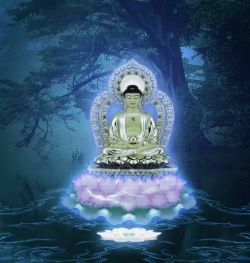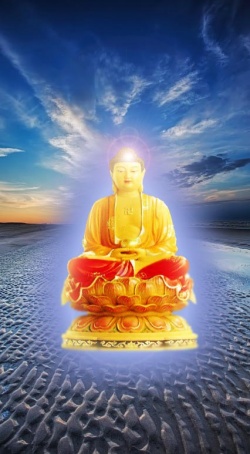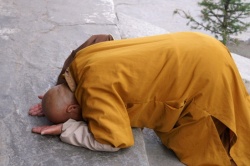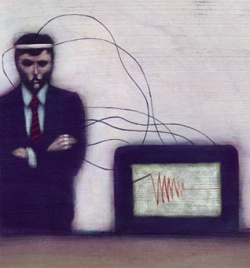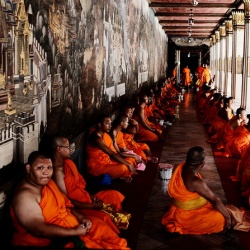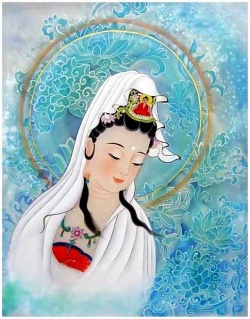Nuns of the unique Joyul (gcod-yul) Sect of Tibetan Buddhism
The Joyul tradition, which was founded in the 11th century, was one of the most important sects of Tibetan Buddhism.
This tradition may trace its origins back to Pha Dampa Sangye, a well-known monk who was a native of South India, and was fouded by Macik Labdron (ma-cig lab-sgron), a famous Tibetan Yogini (a female practitioner of the Yogachara school).
It was the only sect founded by a female in the history of Tibetan Buddhism, and this is also rarely seen in the world history of world religions.
The sect had a unique doctrine and methods of intensive meditative practice.
Therefore, it was a distinctive sect in the Tibetan Buddhism. It not only had deep impact on other sects of Tibetan Buddhism, but also had great influence on Tibetan social life.
The unique teaching and rituals of the Joyul sect had a great impact on nuns in Tibetan-inhabited areas, and became a common practice of the nuns of all other sects of Tibetan Buddhism.
There are two ways to write "Joyul" in Tibetan, i.e."gco-yul" and "spyod-yul."
In the first term, "gcod" means "cut off" or "cut down," and "yul" means "sphere," which refers to the object of mental activities.
The term "gcod-yul" means that the teaching of this sect is (mainly the idea of emptiness, compassion and Bodhichitta, an altruistic aspiration to attain full enlightenment for the benefit of all beings) might remove human suffering and the cycle of life and death.
In the second term "spyod-yul," "spyod" literally means "practice," i.e. "spyod-yul" means to go the way of Bodhisattva's wisdom and to know the nature of all things is empty.
Although there are two ways of writing the name of this sect, yet their meanings are basically the same, i.e. to nullify the ego with Bodhichitta or compassion, to nullify the ego with Prajna and emptiness.
The Joyul sect might trace its origin to Pha Dampa Sangye (pha dam-pa sangs-rgyas) (?-1117), a prominent monk from South India.
Therefore, some Tibetan historical documents refer to this sect as a branch of Shichepa (zhi byed-pa), another sect founded by Pha Dampa Sangye.
According to the Life of Pha Dampa Sangye, when Pha Dampa Sangye came to Tibet for the fourth time (some other documents say it was on his coming to Tibet for the third time), he met with Yarlung Mara Serpo (yar-klungs rmara serpo), who was coming back from India after having learned Buddhist dharma there.
Pha Dampa Sangye taught Mara Serpo of Yarlung Mandrol, Kyo Shakya Yeshe (skyo sha-kya ye-shes), a well-known Nyingmapa siddha
(siddha, - one who has attained spiritual accomplishments) and his two disciples Tsangpa Drachen and Drajung (who came from Nyangtod) the teachings of Joyul that enable one to achieve enlightenment.
Later, the two young men Tsangpa Drachen and Drajung cultivated themselves in accordance with the teaching and attained enlightenment, becoming two siddha Yogins.
This was the earliest situation of Joyul teachings in Tibet.
In line with [[Pha [Dampa Sangye's]] instruction, the Joyul teaching was only circulated secretly among his disciples.
Yarlung Mara Serpo, in his old age, passed on the Joyul teachings to his close attendant Nyingpa Bere.
Kyo Shakya Yeshe, Pha Dampa Sangye's another disciple, passed on this teaching to his nephew Kyo Sonam Lama (skyo bsod-nams bla-ma). From then on the teaching of Joyul sect began to spread in Tibetan-inhabited areas.
As most of the successors to this lineage were male, this lineage was called "male lineage of Joyul sect."
The teaching of the "male lineage of Joyul sect" was mainly concentrated on meditation, in order to negate ignorance, disease and other delusions and temptations of the ego.
The subject matter of this teaching remained fixed and so its sphere of influence in Tibetan society was limited.
2. Yogini Macik Labdron (ma-ciglab-sgron) and the Formation of Joyul Sect
Macik Labdron (1049-1144) was a well-known Yogini (a female practitioner of Yogachara school) in the second propagation period of Tibetan Buddhism. She was born at Tsome (mtsho-smad) in Shannan (Lho-Kha).
Her father, Chokyi Dawa (chos-kyi zla-ba), was a manorial lord, and her mother, Longmo Palgyan, came from a rich family and enjoyed a splendid education in her childhood.
Macik Labdron's parents were kindhearted, piously believing in Buddhism and contributing alms generously. So local people held them in high esteem.
Owing to her family influence, Macik Labdron began to study from a very young age. She could recite the "six-syllable dharani" and "dharani from the Dakini Sutra" at the age of three.
From the age of five onward, the learned to read and studied grammar from her mother and Drakpa Odser, her family-supported monk.
At the age of eight, she was reading and comprehending advanced texts.
She could read "Eight Thousand Verses on the Perfection of Wisdom".(or, the Smaller Prajnaparamita-sutra) twice a day. Her genuine and unique understanding of the Prajna doctrine made her well known in the locality.
People called her Shes-rab Dronme instead of her original name Rinchen Dronme. "Labkyi Dronme" means "the wisdom torch of the locality of Labshi."
Macik is an honorific title, meaning "the sole mother" or "the only respected mother."
While she was beginning to acquire fame, misfortune befell on her.
When she was 13 years old, her mother died. She then lived with her elder sister Tontso Rinchen Bum(ston-mtsho rin-chen-vbum) and studied "Six Paramitas" with Geshe Aton(dge-bshes a-sto).
At age 16, she studied Buddhism with Lama Geshe Drakpa.(dge-bshes grags-pa).
Soon afterwards, her father died. In spite of the grief in her heart, she continued her studies in Smaller Prajnaparamita-sutra, Middle Prajnaparamita-sutra, and Greater Prajnaparamita-sutra with Geshe Drakpa.
Her intelligence and perfect understanding of sutras surprised Geshe Drakpa, who praised her very much and bestowed monastic rodes and a throne on her.
When she was 20, her sister Tontso Rinchen Bum also died. Although she had suffered these repeated emotional setbacks, she was all the more determined to pursue Buddhist truth.
In the same year she met with Kyotongpa Sonam Lama, also called Lama Sonam Drakpa, a well-known Tantric siddha (one who has attained spiritual accomplishments).
She received from him "Four Samadhi Consecrations," "Great Empowerment Consecration" and "Illusion Consecration," as well as other teachings.
Afterwards, she learned from Shamarpa "Five Works of Maitreya", from Lama Pa Donpa (vbav-ston-pa)"Great Perfection (Tib. rdzogschen)" from Lama Yathangpa (g.ya-thang-pa)"Great Mudra," "Six Yogas of Naropa," "[[Sacred] Taro]]," "Kalachakra, or the Wheel of Time," "Three Songs," and Action Tantra, one of the Four Classes of Tantra.
At that time Macik Labdron had gained a fine reputation in Tibet.
Macik Labdron, Majo Changchub of Nyaldoi, Shanmo Gyaltang of Tsang, and Nyalma of Lhasa were called the Four Dakinis of Tibet.
They were four eminent nuns of Tibet in the 11th century.
Macik Labdron, when she learnt Buddhism from Lama Geshe Drakpa of Drathang, met Pha Dampa Sangye.
Pha Dampa Sangye praised Macik Labdron saying, "Macik Labdron has four great wisdoms. She is the incarnation of Dakini. She opens the door of Samadhi. She can subdue evil spirits.
We pay respect to her." I Macik Labdron learnt from Pha Dampa Sangye the teachings of Joyul sect such as Heart Knowledge of Vacancy, Four Consecrations of Samadhi, Instruction on Meditation, Six Ways to Remove Hindrance, and Secret Instructions on Removing Illusion.
Macik Labdron at the age of 23 went to Yuchong to chant confessional sutra.
On her way to Yuchong she engaged in philosophical debate with seven geshes who learnt Prajna-paramita Sutra from Mahasiddha Tonpa Sherab. She won the debate with her profound Buddhist theory and rigorous philosophical logic. Monks paid high respect to her.
They invited her to sit on a throne with incense and music.
Her reputation was rapidly growing. She learnt from Mahasiddha Tonpa Sherab the circulation of Twelve Nidanas and the teaching of returning to nirvana and escaping from the backward flow to transmigration.
She then left the monastic order in Yuchong and married Indian Pandita Topa Draya. (thod-pa gra-ya)
They had two sons and one daughter (or three sons and two daughters by some accounts).
Her second son Tonyon Samdru (thod-smyon bsam-grub )became her main successor and propagator of Macik Labdron's teachings. He became a monk at the age of 15 under the tutorship of Pha Dampa Sangye. Pha Dampa Sangye's original name was Dampa Sangye.
Tonyon Samdru (thod-smyon bsam-grub) treated him as stepfather and called him Pha Dampa Sangye, with "Pha" meaning "father." Since then he was named Pha Dampa Sangye.
Macik Labdron became a nun again after age 34 under the tutorship of Sonam Lama and Lama Drapa. She learnt "Five-Deities Consecration of Pamu Siddhi" from Sonam Lama.
Sonam Lama gave her the tantric name of Dorje Wangchuma (rdo-rje dbang-phyug-ma), which means "Diamond Independent Goddess."
Then she went to Dingri and again received consecration from Pha Dampa Sangye and learnt from him many secret ways to practice meditation.
She made pilgrimage to 108 snowy mountains and the places of "Nyan" (gnyan) (one of aboriginal Tibetan deities), and devoted herself to hard practice of Buddhism in the light of Dampa Sangye's instruction.
Her achievements were great and she became a well-known female master of Tantra.
Source
http://en.tibet.cn/culture/tibetology/200801/t20080117_355771.htm
